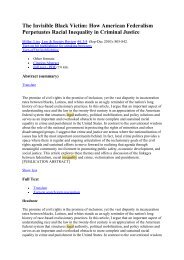Ski – resort and regional development: profile of visitors ... - E-Journal
Ski – resort and regional development: profile of visitors ... - E-Journal
Ski – resort and regional development: profile of visitors ... - E-Journal
You also want an ePaper? Increase the reach of your titles
YUMPU automatically turns print PDFs into web optimized ePapers that Google loves.
Tourist characteristics <strong>and</strong> dem<strong>and</strong> for tourism destination products in nigeria, tropical africa<br />
The second section <strong>of</strong> the questionnaire evaluated the dependent variables <strong>of</strong> tourism product<br />
dem<strong>and</strong> using 3 grouping <strong>of</strong> variables: (1) Type <strong>of</strong> destinations highly patronised or valued<br />
by tourists. (2) Features or image attributes <strong>of</strong> products within destinations considered highly<br />
attractive to tourists. (3) Destination features or their components considered obnoxious/disliked<br />
by tourists. Each <strong>of</strong> these 3 variable groupings that were selected as surrogates for the tourism<br />
products dem<strong>and</strong>ed was evaluated in the questionnaire by asking tourists to rate each on<br />
various 5 point Likert type bi-polar scales. Thus, to evaluate the types <strong>of</strong> tourism destinations<br />
tourists patronise or value most, respondents were requested to rate a set <strong>of</strong> 105 tourists<br />
destinations in Nigeria on a 5 point Likert type scale that was anchored by the bi-polar<br />
adjectives <strong>of</strong> least important to very important for me to visit as a tourists. Next, to evaluate<br />
the specific destination image or components that are highly valued by tourists, respondents<br />
were requested to rate on a 5 point bi-polar scale 28 items on destination features that attracted<br />
or motivated them to selected destinations for visitation. The scale ranged from least important<br />
for me to very important to me in the destination features that determine my decision to visit.<br />
Finally, the distractions/problems encountered in the destinations by tourists were evaluated.<br />
18 items that reflected various dimensions <strong>of</strong> distractions/problems within the destinations<br />
that distracted from the quality <strong>of</strong> each destination were presented to tourists for rating on a<br />
5 point Likert type bi-polar scale that ranged from least important to very important to me<br />
as a problem during visit. The detailed format <strong>and</strong> information on the three sets <strong>of</strong> items<br />
presented to tourists for evaluation <strong>of</strong> destination product dem<strong>and</strong>ed or valued is omitted here<br />
for brevity <strong>of</strong> space. The three sets <strong>of</strong> items presented to tourists for rating were, however,<br />
selected from previous developed <strong>and</strong> published tourism studies by Greewood <strong>and</strong> Moscardo<br />
(2001); Fakeye <strong>and</strong> Crompton, (1997); Awaritefe (1993, 2004) <strong>and</strong> Afolabi, (1993).<br />
Data Analysis<br />
Mean scores obtained for each <strong>of</strong> the 3 sets <strong>of</strong> variable rating schemes were aggregated for<br />
each tourist’s segment, <strong>and</strong> also for the seven destinations separately. The mean scores<br />
obtained for the 3 groups <strong>of</strong> items provided measures for the tourism product dem<strong>and</strong> (y)<br />
used in the multiple regression models <strong>of</strong> study. Mean scores for each <strong>of</strong> all items measured<br />
were obtained by the ranking procedure developed by Nunally (1967). As a result <strong>of</strong> the<br />
abundant data obtained, a factoring technique that involved identifying items with thematic<br />
commonalities developed by Miles <strong>and</strong> Huberman, (1994), was used to scan the data obtained<br />
into various categories or grouping <strong>of</strong> items <strong>of</strong> similar dimensions, with each sharing a common<br />
description factor. Next, these dimensions <strong>of</strong> items were segmented according to tourist’s<br />
demographic characteristics, culture/nationality <strong>and</strong> social groupings. And finally, the means<br />
obtained were presented under each segment. These were used as summary measures for the<br />
various independent tourism product dem<strong>and</strong> variables in the regression models <strong>and</strong> in the<br />
various one-way analysis <strong>of</strong> variance (ANOVA) <strong>and</strong> t-tests to establish significant differences<br />
between various tourists groups in product dem<strong>and</strong>, which is the central hypothesis <strong>of</strong> the<br />
study. Scheffe’s multiple range tests was also applied to ANOVA results to identify tourists’<br />
groups that differed significantly in product dem<strong>and</strong>.<br />
Tourism Today - Fall 2007 - Full Paper<br />
87














